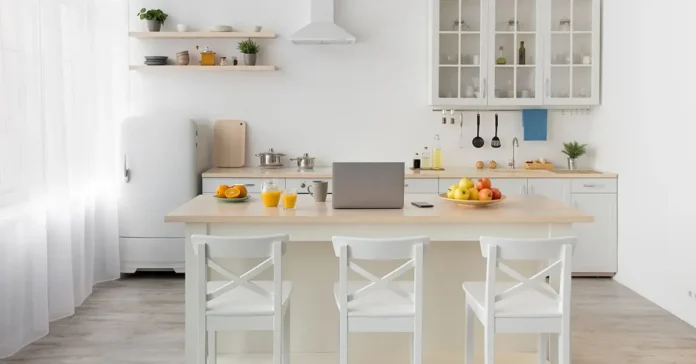In the heart of every home, the dining table stands as a symbol of togetherness. Beyond its functional role as a surface for meals, it elevates the dining experience and sets the tone for gatherings. Understanding the significance of keeping the dining table clean goes beyond mere aesthetics—it’s about creating an inviting space that fosters hygiene and enhances the overall ambiance.
A clean dining table isn’t just about appearances; it’s a reflection of a healthy lifestyle. Regular cleaning not only removes visible dirt and grime but also eliminates unseen germs, creating a safer dining environment for your family and guests. A clean table enhances the visual appeal of the space, making it more welcoming and enjoyable. Whether you’re hosting a casual family dinner or a formal gathering, a well-maintained dining table sets the stage for memorable moments and adds a touch of elegance to every meal.
How to Start the Dining Table Cleaning Process?
Having the right tools at hand not only streamlines the cleaning process but also ensures effective results. Grab a microfiber cloth or a soft sponge, a gentle detergent suitable for your table’s material (such as wood-friendly cleaner, glass cleaner, or pH-neutral cleaner for marble or stone), and a non-abrasive polish for wood tables. These supplies will help you tackle various surfaces and stains without causing damage.
Before diving into cleaning, clear the table of dishes, utensils, and any clutter. This step not only makes the cleaning process more efficient but also prevents items from getting in the way or causing accidental spills.
Cleaning Techniques for Dining Table Cleaning
Maintaining a clean and organised dining table enhances the overall ambiance of your dining area. Here are expert cleaning techniques tailored for various types of dining tables to keep them looking their best.
Surface Cleaning
For everyday cleaning, start by wiping down the table with a damp cloth to remove dust and debris. For stubborn stains, especially from food spills or grease, use a mild detergent solution. Gently scrub the affected areas and wipe clean with a damp cloth.
Wood Table Care
Wooden dining tables require special care to preserve their natural beauty. Use wood-friendly cleaners that nourish the wood while cleaning. After cleaning, polish the table with a soft cloth to maintain its shine and protect it from drying out.
Glass Table Maintenance
Glass tables add a touch of modern elegance to any dining space. To keep them looking pristine, use a glass cleaner for a streak-free shine. Avoid using abrasive cleaners or rough sponges that can scratch the surface and diminish the clarity of the glass.
Marble or Stone Tables
Marble and stone tables exude luxury but require gentle cleaning to prevent damage. Use pH-neutral cleaners specifically formulated for marble or stone surfaces. Periodically sealing the surface adds an extra layer of protection against stains and moisture.
Handling Different Types of Stains
A cleaned dining table is the heart of a welcoming dining experience. However, it’s not uncommon for stains to mark its surface, from spilled food and beverages to accidental ink or marker marks. Knowing how to clean these stains effectively without causing damage is key to maintaining the beauty of your table.
Food and Beverage Stains: These are among the most common stains on dining tables. For fresh spills, gently blot the area with a damp cloth. Avoid rubbing, as this can spread the stain. Use a mild detergent or vinegar solution for tougher stains. For wooden tables, be cautious with abrasive cleaners to prevent damage to the finish.
Ink or Marker Stains: Ink or marker stains can be stubborn, especially on wooden surfaces. Try using rubbing alcohol or a mixture of baking soda and water for removal. Test any cleaning solution on a small patch area first to ensure it doesn’t harm the finish.
Water Rings or Heat Marks: Water rings and heat marks are often caused by hot dishes or glasses placed directly on the table. To remove water rings, apply a mixture of equal parts vinegar and olive oil, then buff gently. For heat marks, use a mixture of baking soda and non-gel toothpaste, applying in circular motions and wiping clean.
Tips for Effective Stain Removal Without Damaging the Table:
- Act quickly
- Always test a cleaning solution on a small area first.
- Avoid harsh scrubbing that can damage the table’s finish.
- For specific table materials, follow recommended cleaning methods.
By following this self storage guide, you can effectively remove stains from your dining table while preserving its beauty and longevity.
Regular Maintenance Tips for Dining Table Cleaning
Maintaining a clean and inviting dining area involves regular upkeep and smart practices. Here are some essential tips for regular maintenance that will help you keep your dining table looking its best:
- Wiping Spills Immediately: Keep a clean cloth handy to wipe up spills as soon as they occur. This not only protects your table’s surface but also maintains its aesthetic appeal.
- Using Placemats or Coasters: Placemats and coasters are not just decorative; they serve a practical purpose too. Placing these items under glasses, plates, and utensils protects your table from heat, moisture, and scratches.
- Dusting Regularly: Dust and debris can accumulate on your dining table, affecting its appearance and cleanliness. Make it a habit to dust your table regularly using a soft cloth or a microfiber duster. This simple step prevents buildup and preserves the table’s shine.
Delicate Dining Table Cleaning
When it comes to special care for antique or delicate tables, using gentle cleaning methods is necessary. These tables, often cherished for their historical or sentimental value, require a delicate touch to preserve their beauty and integrity over time. Here’s a comprehensive guide to caring & decluttering for these precious pieces:
- Use Soft Cloths: Opt for soft, lint-free cloths for cleaning. Microfiber or cotton cloths are ideal as they minimize the risk of scratching delicate surfaces.
- Mild Cleaners: Avoid harsh chemicals that can strip the finish or damage the wood. Instead, use a mild, pH-balanced cleaner specifically designed for delicate surfaces. Dilute it appropriately and test it on a small, patch area first.
- Avoid Excessive Moisture: Antique and delicate tables are susceptible to water damage. Dampen your cloth slightly rather than soaking it, and immediately dry the surface to prevent water penetration.
- Gentle Polishing: Use a gentle, non-abrasive polish designed for antique furniture. Apply it sparingly and buff the surface in gentle circular motions to restore its luster without causing harm.
- Regular Dusting: Dusting regularly with a soft cloth or feather duster helps prevent dirt buildup, which can be abrasive over time.
Final Words on Cleaning Dining Table
Let’s recap some key points that can transform your dining area into a pristine and inviting space. Always begin by preparing the necessary cleaning supplies and clearing the table of any clutter, ensuring a smooth and focused cleaning process. On the basis of your table’s material, choose appropriate cleaning techniques, whether it’s wood, glass, or marble, to maintain its durability and shine.
Handling stains promptly is crucial; address food, beverage, ink, or heat marks using gentle yet effective methods to preserve your table’s aesthetics. Regular maintenance is the cornerstone of a clean dining area, so make it a habit to wipe spills immediately. Also, you can use placemats or coasters, and dust the table regularly to prevent buildup.
FAQs
A: It’s best to clean your dining table after every meal to prevent stains and spills from settling.
A: Use mild dish soap mixed with warm water or specialized wood cleaners to maintain your wooden dining table’s finish.
A: For tough stains, use a gentle mixture of baking soda and water or a commercial stain remover recommended for your table’s material.
A: Yes, diluted white vinegar can be effective for cleaning and disinfecting your dining table, especially for non-porous surfaces like glass or metal.
A: Use placemats, coasters, and tablecloths to protect the surface from scratches caused by utensils, hot plates, or decorative items.
A: It’s best to avoid abrasive cleaners as they can damage the finish of your dining table, especially if it’s made of wood or delicate materials.
A: Use a mixture of water and vinegar or a glass cleaner specifically formulated to prevent streaks for sparkling results.
A: Polishing your dining table occasionally with a furniture polish suitable for its material can help maintain its shine and condition.
A: Use heat-resistant mats or trivets under hot dishes or pots to prevent heat marks or burns on your dining table’s surface.
A: Use a mild dish soap with warm water and avoid acidic cleaners that can etch the marble. Wipe dry immediately to prevent water spots.







